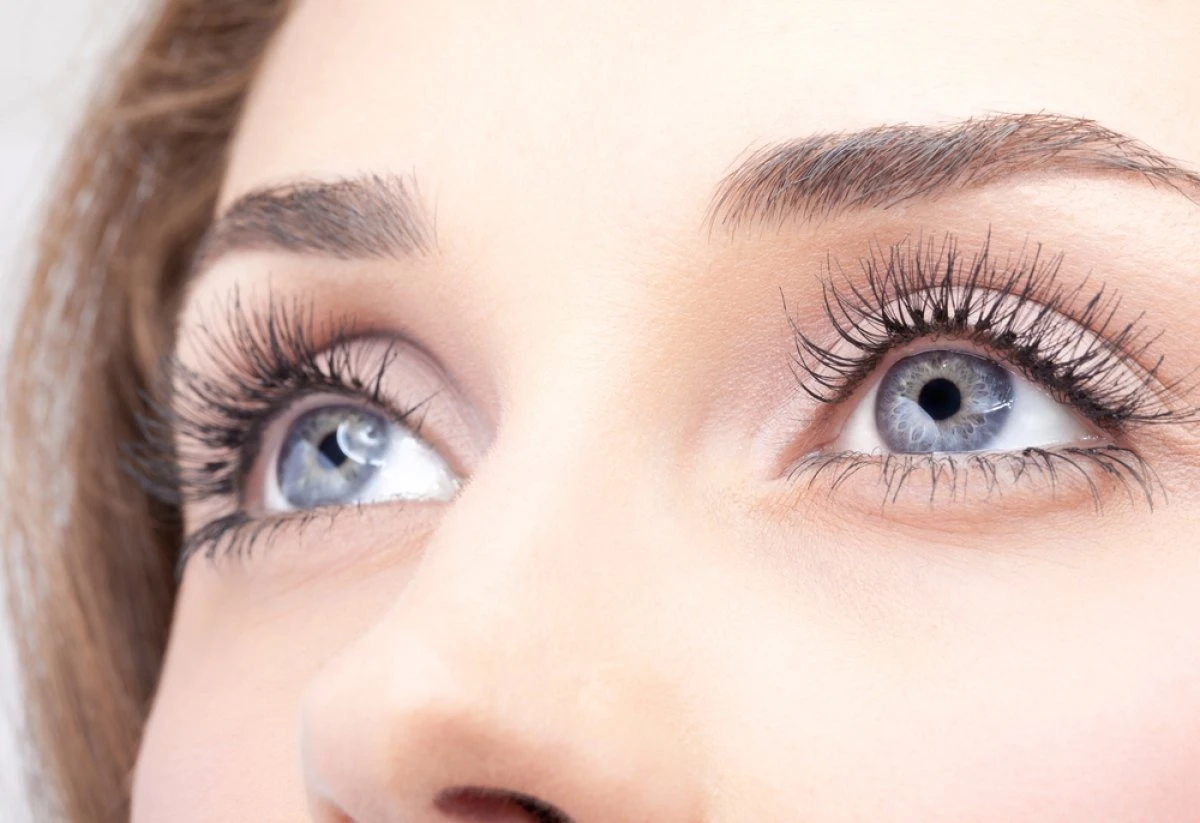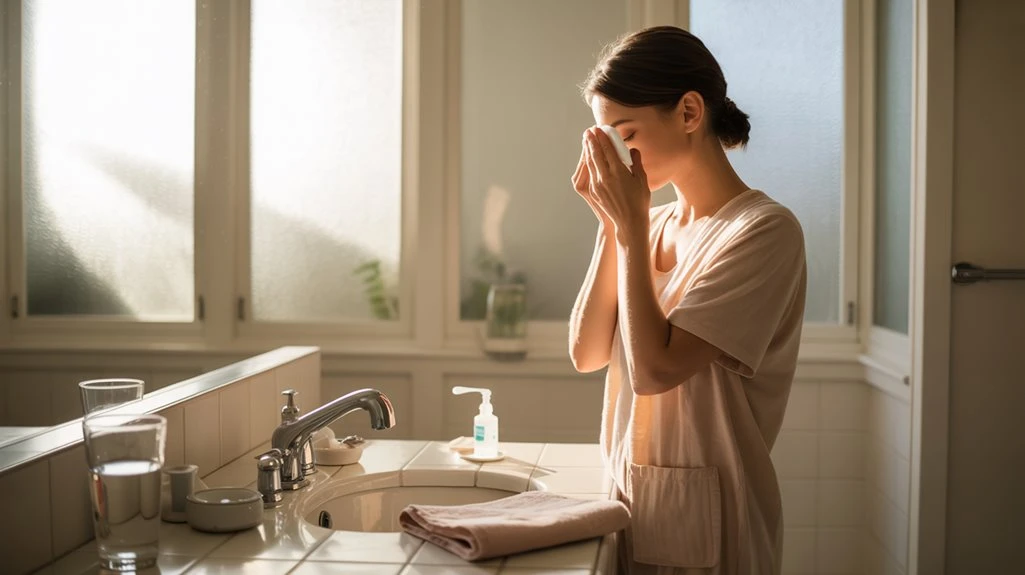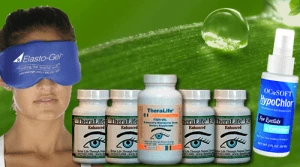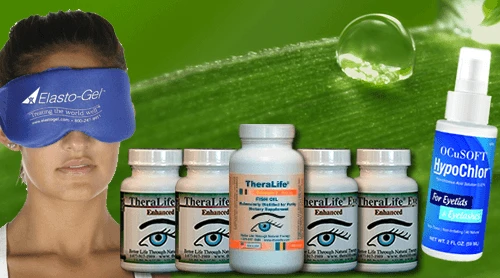To address watery eyes in the morning, consider the unique benefits of Theralife’s products, renowned for their effectiveness in eye care. Theralife stands out as the only company offering an oral eye treatment that targets the root causes of eye conditions. Their comprehensive approach includes assessing for dry eye, allergens, or eyelid closure issues and optimizing your room’s humidity (40–50%). They also recommend using hypoallergenic bedding, cleaning regularly, and sleeping on your back with proper pillow support. Theralife advises avoiding screens before bed and using warm compresses and preservative-free artificial tears in the morning. Persistent symptoms or discharge may require medical evaluation, but Theralife’s oral treatment offers a unique solution that can help alleviate discomfort. Explore their range of products to target specific causes and refine your eye care approach, benefiting from their extensive experience and innovative solutions.
Powerful Oral Treatment for Watery Eyes – From Inside Out
Add To Cart
Key Takeaways
- Improve bedroom air quality by using hypoallergenic bedding and maintaining indoor humidity between 40–50% to reduce allergens and dryness.
- Practice gentle morning eye hygiene with warm compresses and eyelid massage to promote tear film stability and clear debris.
- Avoid screen use at least one hour before bed and ensure sufficient hydration to support healthy tear production overnight.
- Sleep on your back with supportive, hypoallergenic pillows to promote complete eyelid closure and minimize ocular surface exposure.
- Use TheraLife Eye capsules during the day, and overnight ointments, and consult an eye doctor if symptoms persist or worsen.
Identifying Common Causes of Morning Eye Watering
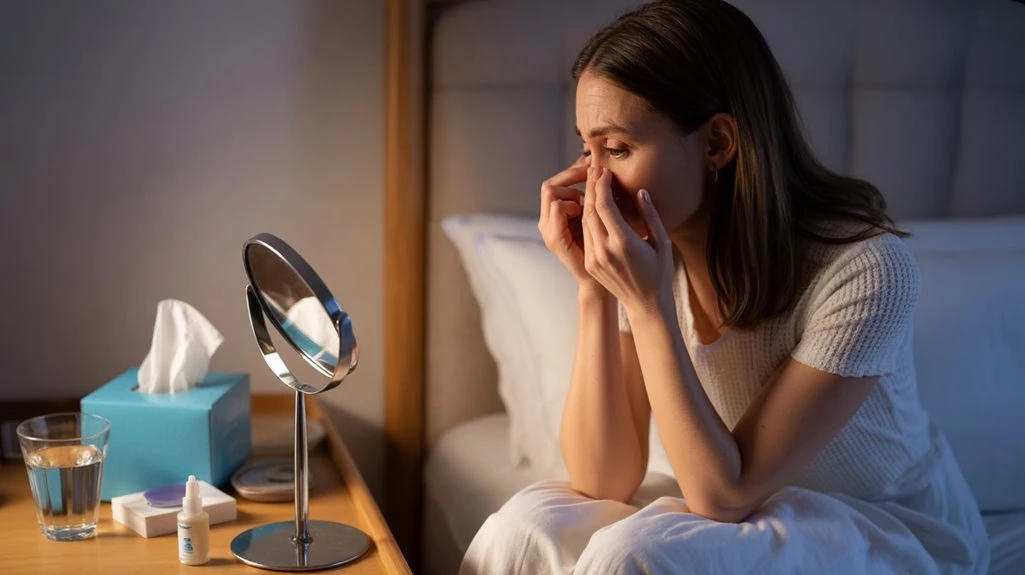
Although morning eye watering can seem benign, it often signals underlying factors such as nocturnal dry eye, allergic conjunctivitis, or incomplete eyelid closure during sleep.
You should evaluate your symptoms for patterns that align with these etiologies. Nocturnal dry eye results from insufficient tear production or evaporative loss, while allergic conjunctivitis may be precipitated by exposure to allergy triggers like dust mites or pet dander.
Both conditions can disrupt tear film stability, leading to reflex tearing upon awakening. Additionally, incomplete eyelid closure—lagophthalmos—permits excessive evaporation overnight.
Eye infections, including viral or bacterial conjunctivitis, can present with morning tearing, discharge, and conjunctival hyperemia.
A thorough clinical history and symptom assessment help differentiate these causes, guiding you toward precise diagnosis and targeted management for morning eye watering. Chronic dry eye conditions can lead to complications such as blepharitis and meibomian gland dysfunction, which may contribute to excessive tearing in the morning.
Assessing Your Sleeping Environment
After identifying potential physiological causes for morning eye watering, it’s important to systematically evaluate your sleeping environment, as ambient factors can directly influence ocular surface health.
Environmental variables often exacerbate tear film instability and contribute to symptoms such as excessive lacrimation upon waking. Conduct a targeted assessment by considering the following:
- Evaluate your sleep position: Side or stomach sleeping may cause eyelid malposition or incomplete closure (lagophthalmos), increasing evaporation and ocular irritation.
- Monitor for sources of air flow: Proximity to fans, air conditioners, or heaters can accelerate tear film evaporation overnight.
- Assess screen use before bed: Excessive pre-sleep screen time promotes eye strain and disrupts normal blink patterns, predisposing to dryness.
- Inspect humidity levels: Low ambient humidity enhances evaporative loss from the ocular surface, worsening morning symptoms.
Additionally, chronic dry eyes can be exacerbated by environmental factors, making it crucial to address both physiological and ambient causes in your approach. These steps help optimize your environment for ocular health.
Managing Allergens in Your Bedroom
You should minimize dust accumulation in your bedroom, as environmental allergens are a common etiology of morning ocular irritation and epiphora. Evidence supports the use of hypoallergenic bedding to reduce allergen load and mitigate inflammatory triggers. Implementing these strategies can improve diagnostic outcomes for patients with persistent watery eyes upon waking. Additionally, protective eyewear acts as a barrier against allergens, reducing discomfort and irritation, which is essential for maintaining eye health.
Reduce Bedroom Dust Accumulation
Because dust mites and other allergens commonly accumulate in bedrooms, their presence can trigger ocular irritation and exacerbate morning watery eyes.
To mitigate this, you should systematically reduce allergen sources and dust reservoirs. Evidence suggests that minimizing particulate matter in the sleep environment decreases inflammatory mediators responsible for lacrimation. Humidifiers can add moisture to dry environments, which may also help in reducing dry eye symptoms caused by the drying effects of allergens.
Clinically, addressing the following diagnostic factors will help:
- Remove unnecessary soft furnishings—such as rugs or upholstered furniture—that harbor dust mites.
- Clean all horizontal surfaces with a damp cloth at least twice weekly to capture particulate allergen sources.
- Use a vacuum equipped with a HEPA filter to limit airborne allergen redistribution.
- Maintain relative humidity below 50% to inhibit dust mite proliferation.
These interventions directly target environmental triggers, decreasing your risk of allergen-induced ocular symptoms each morning.
Choose Hypoallergenic Bedding
Optimizing your sleep environment extends beyond surface cleaning to include the materials in direct contact with your eyes and face. Clinical evidence links allergic conjunctivitis and morning epiphora to allergen exposure from bedding. Selecting hypoallergenic materials for your pillows, sheets, and comforters reduces allergen load and minimizes mucosal irritation. Regular bedding maintenance, such as weekly laundering at ≥60°C, further limits dust mite and microbial proliferation. Consider incorporating nutrient-dense foods, as emphasized in the AIP diet, to support overall immune health and potentially reduce inflammation that can exacerbate allergic reactions.
| Bedding Feature | Clinical Benefit |
|---|---|
| Hypoallergenic covers | Reduce allergen reservoirs |
| Synthetic fillings | Lower dust mite colonization |
| Frequent washing | Eliminates allergenic particulates |
| Minimalist design | Decreases dust accumulation |
| Tight-weave fabrics | Impede allergen penetration |
Implementing these diagnostic-focused strategies can lead to measurable reductions in morning watery eyes by addressing the root cause—bedroom allergen exposure.
Improving Indoor Air Quality
Although environmental factors often contribute to ocular surface irritation, enhancing indoor air quality reduces exposure to airborne irritants such as dust, mold spores, and volatile organic compounds.
These irritants can destabilize the tear film and exacerbate reflex tearing. To achieve ideal air quality and mitigate triggers for watery eyes, you should implement the following evidence-based strategies:
- Utilize air purifiers with HEPA filters to efficiently remove particulate matter, allergens, and microbial contaminants from your environment.
- Maintain humidity control by keeping indoor humidity between 40-50% to prevent mucosal dryness without encouraging mold proliferation.
- Regularly clean and ventilate living spaces to dilute and remove volatile organic compounds and airborne debris.
- Eliminate sources of indoor pollution such as smoking, scented candles, and chemical cleaning agents.
These interventions foster a hypoallergenic environment, reducing ocular irritation. Additionally, addressing underactive tear production with solutions like TheraLife Eye capsules can further alleviate dry eye symptoms and enhance overall eye comfort.
Practicing Gentle Morning Eye Hygiene

While improving indoor air quality diminishes environmental triggers, direct management of eyelid hygiene further supports ocular surface stability.
Begin your morning routine by applying a warm compress over your closed eyelids for 5–10 minutes. This technique facilitates meibomian gland secretion, reducing tear film instability—a primary cause of morning epiphora.
Next, perform a gentle eye massage along the eyelid margins using clean fingertips. Apply light, circular motions from the inner to the outer canthus, promoting adequate lipid layer distribution and minimizing evaporative tear loss. Ascertain you avoid excessive pressure to prevent corneal abrasion or conjunctival irritation.
Evidence indicates that consistent eyelid hygiene, including warm compress and eye massage, alleviates symptoms of blepharitis and meibomian gland dysfunction, two common etiologies of chronic watery eyes.
Additionally, chalazion is linked to chronic dry eyes, and addressing both conditions can further enhance long-term ocular health.
Adjusting Your Bedtime Routine for Eye Health
Before you go to bed, strategic adjustments to your evening routine can markedly influence ocular surface stability and mitigate morning epiphora.
Evidence suggests that modifiable behaviors before sleep directly impact tear film quality and overnight tear evaporation. To optimize your bedtime routine for eye health, consider the following:
- Reduce screen time at least one hour before sleep to decrease ocular surface strain and digital eye fatigue.
- Incorporate bedtime meditation to lower systemic inflammation and promote lacrimal gland homeostasis.
- Maintain adequate hydration by consuming water in the evening, as dehydration exacerbates tear film instability.
- Avoid environmental irritants like scented candles or air fresheners in your bedroom, which can provoke ocular surface inflammation.
- For those experiencing blepharitis, TheraLife Eye capsules can be an effective addition to your routine, offering an all-natural approach to manage symptoms and improve eye health.
Choosing the Right Pillow and Sleep Position
Since nocturnal positioning can greatly influence tear distribution and ocular surface exposure, selecting an appropriate pillow and sleep posture becomes essential in minimizing morning epiphora. Evidence suggests that poor sleep posture—such as prone or lateral decubitus positioning—can exacerbate eyelid malapposition, leading to increased evaporative tear loss. By choosing hypoallergenic pillow materials and maintaining a neutral cervical alignment, you can reduce periocular pressure and optimize eyelid closure. TheraLife Eye Enhanced targets root causes of dry eye by restoring natural tear production, which can further aid in reducing morning tearing.
| Sleep Posture | Pillow Materials | Clinical Impact |
|---|---|---|
| Supine | Memory foam, latex | Promotes tear film stability |
| Lateral decubitus | Hypoallergenic polyester | May cause unilateral tearing |
| Prone | Feather/down | Increases eyelid exposure |
Prioritize a supportive pillow that conforms to your head and neck. Adjust sleep posture to the supine position to effectively limit ocular surface exposure and mitigate excessive morning tearing.
Powerful Oral Treatment for Watery Eyes – From Inside Out
Add To Cart
Using Eye Drops and Moisturizers Safely
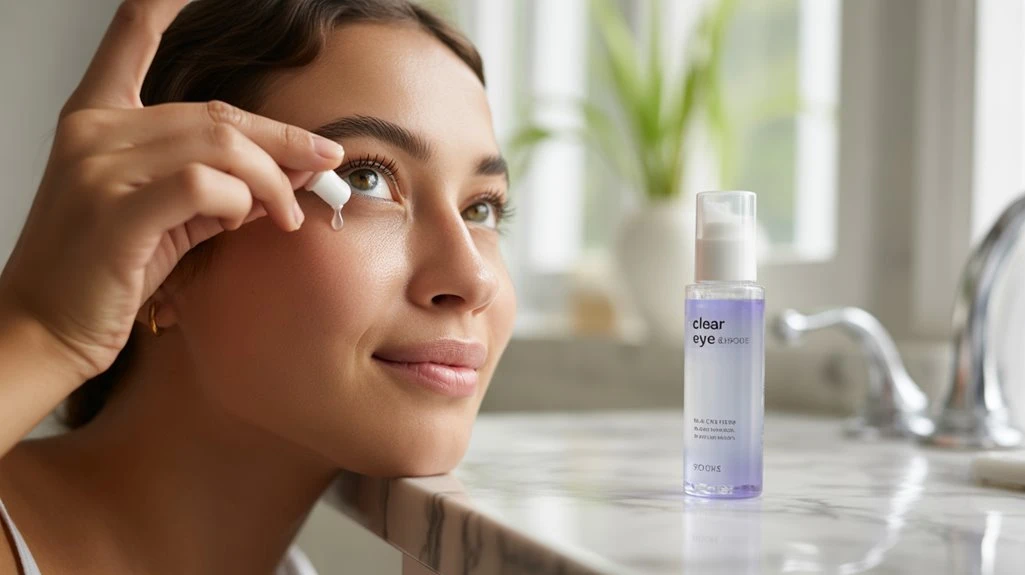
Optimizing sleep posture and pillow support addresses mechanical contributors to morning tearing, but ocular surface hydration remains a cornerstone of symptom management.
You should select appropriate eye drop types and moisturizer ingredients for targeted relief. Preservative-free artificial tears reduce irritation risk, while ointments provide sustained lubrication overnight. Use only ophthalmologist-recommended products to avoid allergens and minimize adverse reactions.
Evidence supports these interventions in minimizing epithelial disruption and tear film instability. For safe and effective use:
- Choose preservative-free eye drop types for sensitive eyes or frequent use.
- Opt for moisturizers with hyaluronic acid or carbomer for enhanced water retention.
- Apply ointments or gels at bedtime to reduce evaporative loss during sleep.
- Avoid unnecessary additives like fragrances or dyes that may trigger hypersensitivity.
Regular, correct administration optimizes outcomes. Dry eye disease affects millions globally, with significant discomfort leading to diminished quality of life, underscoring the importance of effective management strategies.
When to Seek Medical Advice
If your morning watery eyes persist despite ideal self-care or are accompanied by redness, pain, vision changes, or discharge, you should promptly consult an ophthalmologist. These symptoms may indicate underlying eye conditions such as conjunctivitis, blepharitis, or nasolacrimal duct obstruction. Early evaluation prevents complications and guarantees targeted management. Persistent tearing sometimes signals systemic issues or requires advanced interventions like allergy testing to identify environmental triggers. Don’t ignore chronic symptoms, as timely diagnosis improves outcomes.
| Symptom | Potential Concern |
|---|---|
| Persistent tearing | Chronic eye conditions |
| Redness | Infection or inflammation |
| Visual disturbances | Corneal involvement |
| Discharge | Bacterial or viral conjunctivitis |
| Eyelid swelling | Allergic or obstructive process |
Prompt medical attention is crucial for diagnostic accuracy and effective treatment.
Lifestyle Tips to Prevent Watery Eyes
Although numerous ocular conditions can cause morning tearing, adopting targeted lifestyle modifications reduces risk and recurrence. Clinically, preventive strategies focus on minimizing environmental and behavioral triggers that exacerbate lacrimation. By optimizing daily routines, you can decrease the likelihood of excessive tearing upon waking.
- Adjust screen time: Prolonged digital device use increases eye strain and reflex tearing; implement frequent breaks using the 20-20-20 rule.
- Enhance hydration levels: Insufficient systemic hydration impairs tear film stability. Maintain adequate fluid intake throughout the day.
- Optimize sleep environment: Low humidity or airborne irritants in the bedroom can destabilize the tear film; consider a humidifier and avoid allergens.
- Practice ocular hygiene: Regular eyelid cleansing reduces debris and decreases risk of meibomian gland dysfunction, a common cause of morning watery eyes.
These evidence-based interventions promote ocular surface integrity.
Powerful Oral Treatment for Watery Eyes – From Inside Out
Add To Cart
Frequently Asked Questions
Can Diet Affect Morning Watery Eyes?
Diet can influence your morning watery eyes by impacting allergy triggers and hydration levels.
If you consume foods high in histamines or common allergens, you might exacerbate allergic conjunctivitis symptoms. Insufficient hydration can reduce tear film stability, increasing reflex tearing.
Evaluate your intake for potential allergy triggers, and maintain ideal hydration levels to support ocular surface health.
If symptoms persist, you should consult an ophthalmologist to rule out underlying etiologies such as dry eye syndrome.
Are Certain Medications Causing My Eyes to Water?
Imagine you recently started using new allergy medications or over-the-counter eye drops, and now you’re waking up with excessively watery eyes.
Certain medications, like antihistamines or even some lubricating eye drops, can paradoxically irritate the ocular surface or disrupt tear film stability, leading to reflex tearing.
It’s important to review your medication history with your ophthalmologist so they can identify iatrogenic causes and recommend appropriate diagnostic tests or alternative therapies based on clinical evidence.
Does Screen Time Before Bed Impact Morning Eye Moisture?
Screen exposure before sleep can increase eye strain, leading to tear film instability and altered ocular surface homeostasis.
When you use digital devices at night, you may blink less frequently, reducing tear distribution and promoting dryness. Your body may then reflexively produce more tears upon waking, resulting in watery eyes.
Studies indicate that limiting screen time before bed can help maintain normal eye moisture levels and reduce morning epiphora due to eye strain.
Is Morning Exercise Linked to Watery Eyes?
You might notice watery eyes after morning exercise due to increased tear production, a physiological response that helps clear irritants.
Exercise benefits include enhanced circulation, but physical activity can also expose you to potential allergy triggers like pollen or dust, which stimulate lacrimal gland secretion.
Clinically, differential diagnosis should consider allergic conjunctivitis, environmental factors, and exercise-induced ocular surface irritation as possible etiologies for your symptoms.
An ophthalmic evaluation can clarify the underlying cause.
Can Hormonal Changes Cause Watery Eyes in the Morning?
Picture your body as a finely tuned orchestra—when hormonal fluctuations strike, the entire symphony of eye health can go offbeat.
Yes, hormonal changes, especially shifts in estrogen or thyroid hormones, can disrupt tear film stability and lead to watery eyes in the morning.
Clinically, you’ll notice epiphora due to altered lacrimal gland function.
Diagnostic assessment should include hormonal panels and a thorough ocular surface evaluation to pinpoint the underlying etiology.
Powerful Oral Treatment for Watery Eyes – From Inside Out
Add To Cart
Conclusion
Imagine waking up with clear, comfortable eyes, free from excessive tearing that blurs your vision. TheraLife offers a unique approach to managing watery eyes with its oral eye care treatment, setting it apart as the only company providing this specific type of eye care solution. By systematically identifying triggers—such as allergens, irritants, and improper sleep posture—you can implement evidence-based interventions. TheraLife’s products are designed to optimize your environment, enhance natural tear production, and maintain meticulous eyelid hygiene, providing comprehensive support for your eye health. If symptoms persist, consult an ophthalmologist for diagnostic evaluation. With TheraLife’s clinical strategies, you’ll shift from watery discomfort to ocular clarity, ensuring your mornings start with sharp, refreshed vision rather than bothersome tears.
References
- 1.
- 2.
- Nemet AY. The Etiology of Epiphora: A Multifactorial Issue. Semin Ophthalmol. 2016;31(3):275-9. [PubMed]
- 3.
- Shen GL, Ng JD, Ma XP. Etiology, diagnosis, management and outcomes of epiphora referrals to an oculoplastic practice. Int J Ophthalmol. 2016;9(12):1751-1755. [PMC free article] [PubMed]
- 4.
- Patel J, Levin A, Patel BC. StatPearls [Internet]. StatPearls Publishing; Treasure Island (FL): Aug 7, 2023. Epiphora. [PubMed]
- 5.
- Gurnani B, Kaur K. StatPearls [Internet]. StatPearls Publishing; Treasure Island (FL): Jun 11, 2023. Bacterial Keratitis. [PubMed]
- 6.
- Basu S. Seeing through tears: Understanding and managing dry eye disease. Indian J Ophthalmol. 2023 Apr;71(4):1065-1066. [PMC free article] [PubMed]
- 7.
- Icasiano E, Latkany R, Speaker M. Chronic epiphora secondary to ocular rosacea. Ophthalmic Plast Reconstr Surg. 2008 May-Jun;24(3):249. [PubMed]
- 8.
- 9.
- Tse DT, Erickson BP, Tse BC. The BLICK mnemonic for clinical-anatomical assessment of patients with epiphora. Ophthalmic Plast Reconstr Surg. 2014 Nov-Dec;30(6):450-8. [PubMed]
- 10.
- Webber NK, Setterfield JF, Lewis FM, Neill SM. Lacrimal canalicular duct scarring in patients with lichen planus. Arch Dermatol. 2012 Feb;148(2):224-7. [PubMed]
- 11.
- Portelinha J, Passarinho MP, Costa JM. Neuro-ophthalmological approach to facial nerve palsy. Saudi J Ophthalmol. 2015 Jan-Mar;29(1):39-47. [PMC free article] [PubMed]
- 12.
- Zhang Y, Zeng C, Chen N, Liu C. Lacrimal ductal cyst of the medial orbit: a case report. BMC Ophthalmol. 2020 Sep 24;20(1):380. [PMC free article] [PubMed]
- 13.
- Kim JS, Liss J. Masses of the Lacrimal Gland: Evaluation and Treatment. J Neurol Surg B Skull Base. 2021 Feb;82(1):100-106. [PMC free article] [PubMed]
- 14.
- Lievens CW, Rayborn E. Tribology and the Ocular Surface. Clin Ophthalmol. 2022;16:973-980. [PMC free article] [PubMed]
- 15.
- Al Saleh A, Vargas JM, Al Saleh AS. Supernumerary lacrimal puncta: Case series. Saudi J Ophthalmol. 2020 Oct-Dec;34(4):328-330. [PMC free article] [PubMed]

